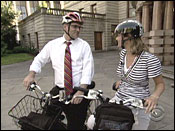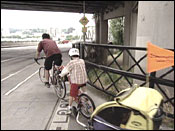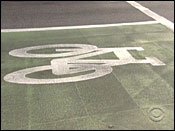Here is a great video from the CBS morning news which talks how bicycling and bikes are being viewed differently by the American public, everything from supported bike touring to bicycle commuting. The text is as follows:
(CBS) "Pedal Power" is coming into its own these days, as Americans of all ages are coming to realize biking can be practical, economical, and good clean fun - or should we say, good GREEN fun? Our Cover Story takes us from California to Cambridge, and is reported by Serena Altschul:
"Learn to ride a bicycle," Mark Twain once wrote. "You will not regret it if you live."
On a cool Summer morning, a dozen bicyclists are living the good life on two wheels. Their backroads tour out of Sonoma, Calif., takes them through wine country.
"There's really no better way to see something, to see a place really well than by biking," said one rider. "You're presented with the smells and sounds of nature. For me, this is a very Zen ,relaxing thing."
Relaxing, and refreshing.
Today's ride of about 40 miles is new for some ("I actually am not a big biker<' admits one), and for others, it's just another day. "We ride about 5,000 miles a year," one couple said. "A hundred miles a week." A coast away, at the Bicycle Riding School in Somerville, Mass., a drama is unfolding as Sue Ghezzi and three other students are about to take the saddle for the very first time. "Isn't that a shock - I've never ridden before," she said. "I grew up in New York City and I probably didn't see a bike until I was a teenager." Instructor Susan McLucas tells one of her students, "You're going to go wherever the bike wants. Surrender to the bike. The bike is the master." "All of them think they're the
only one," said McLucas.
Over the past 25 years, she has taught 2,000 grownups to keep their balance.
"I feel like I'm kind of doing half-therapy, half-bicycle riding teaching."
"I hope you're capturing all the terror in my face!" laughs one novice.
Teacher or therapist, Susan gets the same result.
"It feels good, it feels really good," said Imelda.
And that's been the idea right from the start, though the earliest versions of the bicycle back in the early 19th century weren't nearly as comfortable. Foot-powered, then pedaled on a big front wheel, the bicycle became the machine we know today by the 1880s - "A pretty extraordinary device," is how president Andy Clarke of the League of American Bicyclists describes it.
"It led to all kinds of innovations that we take for granted, both in the bicycling world, but also in the world of the automobile: suspension, pneumatic tires, gearing systems, braking, all of which really got their start with the bicycle."
It was also a social force.
"What the bicycle offered was a kind of liberation in terms of movement, an independent, affordable means of transportation," Clarke said.
Especially for women. Suffragette Susan B. Anthony wrote that the bicycle "has done more to emancipate women than anything else in the world." She called it "the freedom machine."
With gas prices now more than four dollars a gallon, for some the bicycle today is turning into a different kind of freedom machine. Not long ago, just down the road from the Bicycle Riding School, Julian Richards embarked on a first of his own - as a bicycle commuter.
By cycling to work each day, Richards estimates he could save up to $5,000 a year.
"So you're saving money,"
Altschul said. "Are there any other noticeable benefits for you?"
"Absolutely. I don't mind telling you that I've dropped 10 pounds in 2 months."
At Landry's Bicycles in Boston, they say it's becoming a familiar story.
"We've absolutely seen the price of gas affect bicycle sales," said manager Mark Vatour. "You know at Landry's we've seen bikes used for transportation. Sales have increased 70 percent."
Bicycle stores across the country are reporting the same thing.
Yet nationally, fewer than one percent of Americans commute to work by bike. The problem for these new commuters is where to ride safely.
Boston, like hundreds of communities across the country, has miles of bike paths. Still, when it comes to cycling in the central city, "It's definitely challenging," said David Watson, the executive director of the Massachusetts Bicycle Coalition. "I wouldn't recommend that an inexperienced cyclist just dive into commuting in Boston traffic."
He says Boston is at the very beginning of improving its infrastructure for cycling.
Several cities like San Francisco, Chicago and Minneapolis are known for their bicycle facilities. But the one that's farthest down the road in making itself bike friendly is Portland, Oregon.
Mayor-elect Sam Adams is Portland's transportation commissioner. He'll soon preside over the country's biggest bicycling success story.
Remember, less than one percent of Americans cycle for transportation, but here in Portland, that number reaches six percent, and as high as 15 percent in some neighborhoods.
At Clever Cycles, Portlanders can even buy the bike equivalent of an SUV. One model can carry a thousand pounds.
Spend a little time in Portland, and you'll soon be struck by not just the number of bikers, but their variety.
The mayor-elect, whom everyone here calls Sam, rode to victory on a bicycle platform. He's probably posed with more bikes than babies.

(CBS)
took a ride with him to see what makes Portland different.
"We've seen, you know, nearly 150% increase in the last 10 years of trips made by bikes, especially in the central city," Adams told her. "And it makes me proud because, you know, imagine all the smog we're
not producing with these bikes trips. Imagine all the health improvements."
Fifteen years ago, Portland looked to European cities like Copenhagen and Amsterdam, where more than a quarter of all trips are taken by bike, for inspiration.
Mia Birk was Portland's first bike coordinator: "We developed a bike plan, we developed a bikeway network and we started building it so that people really could be able to bicycle for their daily transportation needs."
She says that behind the city's 300-mile bike network is a new philosophy: "Driving has been a part of our culture for a hundred years now, and is such a predominant part of our culture that we don't even recognize it. People think that's just the way to get around."
Portland has added the bicycle into the mix.
"It's just the way we get around," Birk said. "It's just what we do."
Dan Kaufman has taken that message to heart. When this work-at-home dad needs to pick up his son from dance class, he puts his family on what he calls the "bike train" … for a 12-mile ride.

(CBS)
"And are there a lot of families like you guys that do this that you're aware?"
Altschul asked.
"Oh yeah, this is not a big deal," Kaufman said.
"Totally normal?"
"Totally. This is, in Portland. There's people who, I don't consider myself 'uber' at all."
"How does your wife feel about the bike train and you guys being out on the road so much?"
Altschul said.
"She wasn't too thrilled at first," he said. "And I definitely ride very defensively. I mean, this is my family here."
Still, even in this biking nirvana, accidents happen. Last October, Portland was jolted by the deaths of two cyclists.
"And you know, how do you get over that?" Adams said. "Respond very decisively, and in a smart way."

(CBS)
As a result of those deaths, Portland installed special pavement markings called "green boxes" at some city intersections, in which bicyclists can stop in front of cars, "so they can't miss us," Adams said.
And can other cities have what Portland has?
"I'll just challenge your viewers to think about substituting one trip a week that they normally take by car, try it on a bike," Birk said. "Try a short trip that's 2 miles or less."
According to a recent federal study, that's 40% of all urban trips in America.
"See how much easier it is than you think it is," Birk said. "Just try it."
So, thinking of dusting off that bike? It is, after all, a Sunday in the Summer.

















